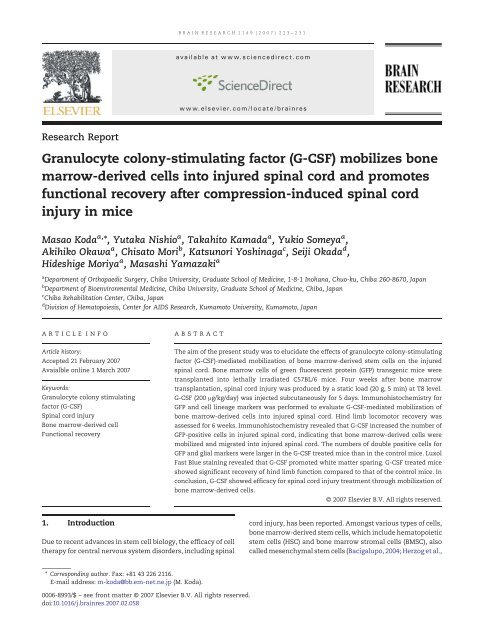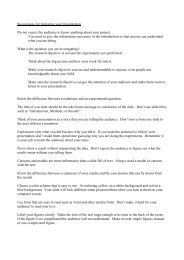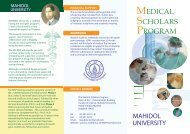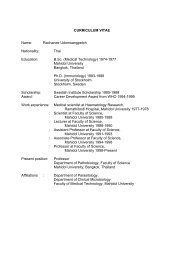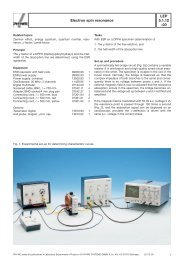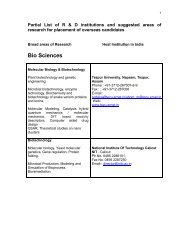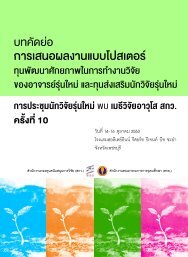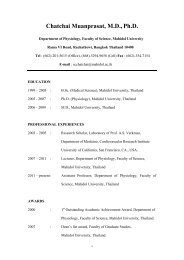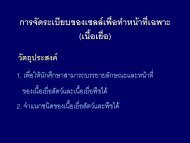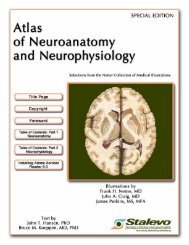Granulocyte colony-stimulating factor (G-CSF ... - ResearchGate
Granulocyte colony-stimulating factor (G-CSF ... - ResearchGate
Granulocyte colony-stimulating factor (G-CSF ... - ResearchGate
Create successful ePaper yourself
Turn your PDF publications into a flip-book with our unique Google optimized e-Paper software.
BRAIN RESEARCH 1149 (2007) 223– 231<br />
available at www.sciencedirect.com<br />
www.elsevier.com/locate/brainres<br />
Research Report<br />
<strong>Granulocyte</strong> <strong>colony</strong>-<strong>stimulating</strong> <strong>factor</strong> (G-<strong>CSF</strong>) mobilizes bone<br />
marrow-derived cells into injured spinal cord and promotes<br />
functional recovery after compression-induced spinal cord<br />
injury in mice<br />
Masao Koda a, ⁎, Yutaka Nishio a , Takahito Kamada a , Yukio Someya a ,<br />
Akihiko Okawa a , Chisato Mori b , Katsunori Yoshinaga c , Seiji Okada d ,<br />
Hideshige Moriya a , Masashi Yamazaki a<br />
a Department of Orthopaedic Surgery, Chiba University, Graduate School of Medicine, 1-8-1 Inohana, Chuo-ku, Chiba 260-8670, Japan<br />
b Department of Bioenvironmental Medicine, Chiba University, Graduate School of Medicine, Chiba, Japan<br />
c Chiba Rehabilitation Center, Chiba, Japan<br />
d Division of Hematopoiesis, Center for AIDS Research, Kumamoto University, Kumamoto, Japan<br />
ARTICLE INFO<br />
Article history:<br />
Accepted 21 February 2007<br />
Avaialble online 1 March 2007<br />
Keywords:<br />
<strong>Granulocyte</strong> <strong>colony</strong> <strong>stimulating</strong><br />
<strong>factor</strong> (G-<strong>CSF</strong>)<br />
Spinal cord injury<br />
Bone marrow-derived cell<br />
Functional recovery<br />
ABSTRACT<br />
The aim of the present study was to elucidate the effects of granulocyte <strong>colony</strong>-<strong>stimulating</strong><br />
<strong>factor</strong> (G-<strong>CSF</strong>)-mediated mobilization of bone marrow-derived stem cells on the injured<br />
spinal cord. Bone marrow cells of green fluorescent protein (GFP) transgenic mice were<br />
transplanted into lethally irradiated C57BL/6 mice. Four weeks after bone marrow<br />
transplantation, spinal cord injury was produced by a static load (20 g, 5 min) at T8 level.<br />
G-<strong>CSF</strong> (200 μg/kg/day) was injected subcutaneously for 5 days. Immunohistochemistry for<br />
GFP and cell lineage markers was performed to evaluate G-<strong>CSF</strong>-mediated mobilization of<br />
bone marrow-derived cells into injured spinal cord. Hind limb locomotor recovery was<br />
assessed for 6 weeks. Immunohistochemistry revealed that G-<strong>CSF</strong> increased the number of<br />
GFP-positive cells in injured spinal cord, indicating that bone marrow-derived cells were<br />
mobilized and migrated into injured spinal cord. The numbers of double positive cells for<br />
GFP and glial markers were larger in the G-<strong>CSF</strong> treated mice than in the control mice. Luxol<br />
Fast Blue staining revealed that G-<strong>CSF</strong> promoted white matter sparing. G-<strong>CSF</strong> treated mice<br />
showed significant recovery of hind limb function compared to that of the control mice. In<br />
conclusion, G-<strong>CSF</strong> showed efficacy for spinal cord injury treatment through mobilization of<br />
bone marrow-derived cells.<br />
© 2007 Elsevier B.V. All rights reserved.<br />
1. Introduction<br />
Due to recent advances in stem cell biology, the efficacy of cell<br />
therapy for central nervous system disorders, including spinal<br />
cord injury, has been reported. Amongst various types of cells,<br />
bone marrow-derived stem cells, which include hematopoietic<br />
stem cells (HSC) and bone marrow stromal cells (BMSC), also<br />
called mesenchymal stem cells (Bacigalupo, 2004; Herzog et al.,<br />
⁎ Corresponding author. Fax: +81 43 226 2116.<br />
E-mail address: m-koda@bb.em-net.ne.jp (M. Koda).<br />
0006-8993/$ – see front matter © 2007 Elsevier B.V. All rights reserved.<br />
doi:10.1016/j.brainres.2007.02.058
224 BRAIN RESEARCH 1149 (2007) 223– 231<br />
2003), are candidates for cell therapy of spinal cord injury,<br />
because they can be transplanted autologously. Indeed,<br />
transplantation of HSC promotes functional recovery after<br />
compression-induced spinal cord injury in mice, as we<br />
reported previously (Koshizuka et al., 2004; Koda et al., 2005),<br />
and transplantation of BMSC significantly improves hind limb<br />
function after spinal cord injury in mice and rats (Chopp et al.,<br />
2000; Hofstetter et al., 2002; Wu et al., 2003). These lines of<br />
evidence show the potential of bone marrow-derived stem<br />
cells to restore injured spinal cord tissue and to promote<br />
functional recovery.<br />
<strong>Granulocyte</strong> <strong>colony</strong>-<strong>stimulating</strong> <strong>factor</strong> (G-<strong>CSF</strong>) is widely<br />
known as a cytokine that induces survival, proliferation and<br />
differentiation of cells of the neutrophil lineage (Nicola et<br />
al., 1983; Roberts, 2005). Further, G-<strong>CSF</strong> can mobilize bone<br />
marrow cells into peripheral blood, an action used clinically<br />
for patients with leukocytopenia and for donors of peripheral<br />
blood-derived HSCs for transplantation (Jansen et al.,<br />
2005). Bone marrow-derived stem cells mobilized by G-<strong>CSF</strong><br />
may have the potential to migrate into and repair various<br />
injured tissues. For example, G-<strong>CSF</strong> has been shown to<br />
mobilize bone marrow-derived stem cells to repair the<br />
ischemic myocardium (Orlic et al., 2001; Kawada et al.,<br />
2004). As for the central nervous system, bone marrow cells<br />
mobilized by G-<strong>CSF</strong> migrate into, survive and express a<br />
neural phenotype in normal brain (Corti et al., 2002a), spinal<br />
cord and dorsal root ganglia (Corti et al., 2002b). Moreover,<br />
G-<strong>CSF</strong> mobilized bone marrow cells into the ischemic brain<br />
and promoted functional recovery (Kawada et al., 2006). The<br />
influence of G-<strong>CSF</strong>-mediated mobilization of bone marrowderived<br />
stem cells on the injured spinal cord remains to be<br />
elucidated.<br />
Here we showed that G-<strong>CSF</strong> promoted the mobilization and<br />
migration of bone marrow cells into the spinal cord, the<br />
restoration of damaged spinal cord tissue and the recovery of<br />
hind limb function.<br />
2. Results<br />
Mice tolerated the irradiation and bone marrow transplantation<br />
well. FACS analysis showed that approximately 80% of the<br />
whole bone marrow cells were positive for GFP 4 weeks after<br />
bone marrow transplantation, indicating that GFP Tg-derived<br />
bone marrow cells survived and reconstituted hematopoiesis<br />
in grafted mice (not shown).<br />
At first, we analyzed GFP fluorescence to detect bone<br />
marrow-derived cells in the intact spinal cord. The average<br />
number of GFP-positive cells was 33.6 (16–46) per section in the<br />
PBS group and 40.3 (18–61) per section in the G-<strong>CSF</strong> group (Fig.<br />
1D). GFP-positive cells were located mainly in the white matter<br />
and subpial zone (Figs. 1A–C). There was no significant<br />
difference between the numbers of GFP-positive cells in the<br />
PBS and G-<strong>CSF</strong> groups (Fig. 1D).<br />
Twenty-four hours after injury, GFP-positive cells had<br />
accumulated in the lesion epicenter. Most of the GFP-positive<br />
cells in the lesioned site were round, and the remaining were<br />
spindle-shaped (Figs. 2A, D). There was no significant difference<br />
between the number of GFP-positive cells in the SCI+PBS<br />
and SCI+G-<strong>CSF</strong> groups (352.4±24.2 in the SCI+PBS group and<br />
331.7±23.6 in the SCI+G-<strong>CSF</strong> group, Fig. 2F). Next, we<br />
performed immunohistochemistry for cell-specific markers<br />
to elucidate the phenotype of GFP-positive cells in the injured<br />
spinal cord. Twenty-four hours after injury, GFP-positive<br />
Fig. 1 – Immunohistochemistry for GFP in normal spinal cord after PBS (A) or G-<strong>CSF</strong> (B) injection. (C) is the higher-magnification<br />
view indicated as a box in (B). There was no significant difference in the number of GFP-positive cells between the PBS and<br />
G-<strong>CSF</strong> groups (D). GFP-positive cells were located in the white matter and subpial zone (C). Bars=500 μm (A, B) and 30 μm (C).<br />
Values are mean±S.E.M. (D).
BRAIN RESEARCH 1149 (2007) 223– 231<br />
225<br />
Fig. 2 – Immunohistochemistry for GFP and cell-specific markers in the acute phase of spinal cord injury. Near the lesion<br />
epicenter, GFP-positive round cells were also positive for neutrophil antigen (A–C, D, arrows). GFP-positive spindle-shaped cells<br />
negative for neutrophil antigen were observed (D, arrowheads). Some of the GFP-positive spindle-shaped cells were positive for<br />
vimentin, a marker for cells of the mesenchymal lineage (E, arrow). There was no significant difference in the number of<br />
GFP-positive cells between the SCI+PBS and SCI+G-<strong>CSF</strong> groups (F). The number of GFP- and neutrophil-double-positive cells<br />
was smaller in the SCI+G-<strong>CSF</strong> group than in the SCI+PBS group (F, hatched column, p
226 BRAIN RESEARCH 1149 (2007) 223– 231<br />
2E, arrow). No cells were double-positive for GFP and a neural<br />
lineage marker in the injured spinal cord in both the SCI+PBS<br />
and SCI+G-<strong>CSF</strong> groups 24 h after injury (not shown).<br />
To confirm G-<strong>CSF</strong>-mediated mobilization of bone marrowderived<br />
hematopoietic stem cells, we performed immunohistochemistry<br />
for CD34 one week after injury. In the SCI+G-<strong>CSF</strong><br />
group, GFP- and CD34-double-positive cells were detected<br />
near the lesion epicenter (Figs. 2G–I, arrow).<br />
Six weeks after injury, there were many GFP-positive round<br />
cells in the lesioned site and cells with some processes in the<br />
white matter (Figs. 3A, B). The number of GFP-positive cells in<br />
the SCI+G-<strong>CSF</strong> group was significantly larger than that in the<br />
SCI+PBS group 6 weeks after injury (449.0±28.5 in the SCI+PBS<br />
group and 610.3±21.9 in the SCI+G-<strong>CSF</strong> group, p
BRAIN RESEARCH 1149 (2007) 223– 231<br />
227<br />
Fig. 5 – Quantitative analysis of double-positive cells for GFP and cell-specific markers 6 weeks after injury. The numbers<br />
of double-positive cells for GFP and Mac-1 (A), GFP and GFAP (B), GFP and APC (C) and GFP and nestin (D) were significantly larger<br />
in the SCI+ G-CSG group than that in the SCI+PBS group. Values are mean±S.E.M. ⁎p
228 BRAIN RESEARCH 1149 (2007) 223– 231<br />
Fig. 7 – Hind limb functional assessment with the hind limb<br />
motor function scale (Farooque et al., 2001; Table 1). Time<br />
course of hind limb functional recovery (A) and comparison of<br />
final motor function score between the groups (B). Mice from<br />
the SCI+G-<strong>CSF</strong> group (square) showed significant recovery<br />
compared to mice from the SCI+PBS group (circle). Values are<br />
mean± S.E.M. ⁎p
BRAIN RESEARCH 1149 (2007) 223– 231<br />
229<br />
investigation is needed to elucidate these mechanisms of<br />
action of G-<strong>CSF</strong>.<br />
Regarding the clinical application of G-<strong>CSF</strong> for the treatment<br />
of spinal cord injury, G-<strong>CSF</strong> has some advantages over<br />
other treatments under investigation. First, G-<strong>CSF</strong> has already<br />
been approved as a safe drug, and it is widely used in clinics.<br />
Second, G-<strong>CSF</strong>-mediated mobilization of bone marrowderived<br />
cells does not require injection of the cells directly<br />
into the lesioned spinal cord, thus avoiding additional trauma.<br />
Moreover, G-<strong>CSF</strong>-mediated mobilization of bone marrowderived<br />
cells does not require harvesting and cultivation of<br />
any cells in vitro, resulting in the avoidance of associated risks<br />
including contamination, tumor formation, immunological<br />
rejection and ethical problems.<br />
In conclusion, G-<strong>CSF</strong> promotes the migration of bone<br />
marrow-derived cells into the lesioned spinal cord and the<br />
recovery of hind limb function. The present results encourage<br />
the use of G-<strong>CSF</strong> to treat spinal cord injury, although further<br />
investigation is needed to advance G-<strong>CSF</strong> treatment for this<br />
clinical application.<br />
4. Experimental procedure<br />
4.1. Bone marrow transplantation<br />
Bone marrow cells were collected from 8- to 12-week-old male<br />
green fluorescent protein transgenic mice (GFP Tg; Okabe et al.,<br />
1997). GFP Tg mice were euthanized with a pentobarbital<br />
overdose, and femurs and tibias were removed and placed in<br />
cold phosphate-buffered saline (PBS). After removal of the<br />
epiphyses of the femurs and tibias, the marrow was flushed<br />
out with PBS using a 26G needle attached to a syringe. A total of<br />
6×10 6 bone marrow cells derived from GFP Tg mice were<br />
transplanted intravenously via the tail vein of lethally<br />
irradiated (10 Gy) female C57BL/6 mice (SLC, Hamamatsu,<br />
Japan). Four weeks after bone marrow transplantation, whole<br />
bone marrow cells were collected as mentioned above for<br />
fluorescence-activated cell-sorter (FACS) scanner analysis<br />
with FACScan (Becton Dickinson, San Jose, CA) to evaluate<br />
chimerism (n=2).<br />
4.2. Spinal cord injury and G-<strong>CSF</strong> treatment<br />
Four weeks after bone marrow transplantation, surgery and G-<br />
<strong>CSF</strong> treatment were performed. A total of 38 mice were used in<br />
the present study. Animals were divided into four groups,<br />
including spinal cord injury with G-<strong>CSF</strong> treatment (SCI+G-<strong>CSF</strong><br />
group; n=14), spinal cord injury with vehicle control (SCI+PBS<br />
group; n=14), sham operation with G-<strong>CSF</strong> treatment (G-<strong>CSF</strong><br />
group; n=5) and sham operation without G-<strong>CSF</strong> treatment<br />
(PBS group; n=5). Under halothane anesthesia, laminectomy<br />
was performed at the Th7–8 level, leaving the dura intact. The<br />
animals were then placed in a stereotaxic apparatus, and two<br />
adjustable forceps were applied to the spinous processes of<br />
both T6 and T9 to stabilize the spine. The dural tube was<br />
compressed with a steady load of 20 g for 5 min at the site of<br />
the Th7–8 laminectomy. The tip of the weight was a 1×2-mm<br />
rectangular plastic plate (Farooque et al., 2001). The mice were<br />
kept under a heating lamp until they regained consciousness.<br />
No pre- or post-operative antibiotics were given. Bladder<br />
function was observed during the first days after trauma for<br />
signs of urinary retention. Food and water were provided ad<br />
libitum before and after the experiments. The mice were kept<br />
in a temperature-controlled environment of 20 °C, and were<br />
exposed to alternate light and dark periods of 12 h. All animals<br />
were treated and cared for in accordance with the Chiba<br />
University School of Medicine guidelines pertaining to the<br />
treatment of experimental animals.<br />
Immediately after injury, recombinant human G-<strong>CSF</strong><br />
(200 μg/kg/day; kindly provided by Kirin Brewery Co. Ltd.,<br />
Pharmatheutical Division, Tokyo, Japan) or vehicle alone (1%<br />
bovine serum albumin in PBS) was injected subcutaneously for<br />
5 days in each group.<br />
4.3. Assessment of locomotor activity<br />
The functional recovery of hind limb of mice in the SCI+G-<strong>CSF</strong><br />
(n =10) and SCI+PBS (n =10) groups was determined by<br />
measuring the hind limb motor function score as previously<br />
described by Farooque et al. (2001). Mice were allowed to move<br />
freely on the open field with rough surface for 5 min at each<br />
time tested. The hind limb movement of mice were videotaped<br />
and scored by two independent observers who were<br />
unaware of the treatment. Measurement of motor function<br />
was performed before surgery, 1 and 3 days and 1–6 weeks<br />
(once a week) after spinal cord injury. The scale ranged from 0<br />
to 13, and scores were as shown in Table 1. In brief, score 0<br />
means complete paralysis, scores 1–3 means movements of<br />
hind limbs without rhythmical stepping, scores 4 and 5 mean<br />
rhythmical motion of hind limbs without weight bearing<br />
ability, scores 6 and 7 mean weight bearing ability, scores 8–12<br />
Table 1<br />
Score<br />
Criteria<br />
0 No noticeable movements of the hind limbs.<br />
1 Occasional, barely visible movements of any hind limb<br />
joint (hip, knee, or ankle).<br />
2 Obvious movements of one or more joints in one hind limb<br />
but no forwards propulsive, stepping movements.<br />
3 Obvious movements of one or more joints in both hind<br />
limbs but no forwards propulsive, stepping movements.<br />
4 Stepping and forwards propulsive movement of one hind<br />
limb. No weight-bearing. Often external rotation of the<br />
hind limb.<br />
5 Alternate stepping and forwards propulsive movements of<br />
both hind limbs but no weight-bearing ability. Often<br />
external rotation of hind limbs.<br />
6 Weight-bearing ability of hind limbs but no normal walking<br />
(external rotation of one or both limbs and/or hip<br />
instability). The animals sweep one or both feet while<br />
walking (an obvious friction noise can be heard).<br />
7 Weight-bearing ability of hind limbs, walks with a mild<br />
deficit (slight external rotation of one or both limbs and/or<br />
hip instability).<br />
8 Normal movements except for reduced speed of walking.<br />
9 Normal movements, ability to walk on a 2-cm wide bar.<br />
10 Normal movements, ability to walk on a 1.5-cm wide bar.<br />
11 Normal movements, ability to walk on a 1-cm wide bar.<br />
12 Normal movements, ability to walk on a 7-mm wide bar.<br />
13 Normal movements, ability to walk on a 5-mm wide bar.
230 BRAIN RESEARCH 1149 (2007) 223– 231<br />
means walking ability with increase of the hind limb gait<br />
width and score 13 means full recovery.<br />
Mice in both the G-<strong>CSF</strong> and PBS groups were excluded<br />
from behavioral assessment, because they showed no apparent<br />
neurological deficit throughout the experimental period.<br />
4.4. Tissue preparation<br />
For histological evaluation, animals in all of the groups were<br />
perfused transcardially with 4% paraformaldehyde in PBS (pH<br />
7.4) under pentobarbital anesthesia 1 day (n=4/group) and<br />
6 weeks (n=10/group) after surgery. Three segments of spinal<br />
cords, including the lesion epicenter (T7–9) were removed and<br />
postfixed in the same fixative overnight, stored in 20% sucrose<br />
in PBS at 4 °C, and embedded in OCT compound (Sakura<br />
Finetechnical, Tokyo, Japan). The cryoprotected samples were<br />
frozen and kept at −80 °C until use. The samples were cut into<br />
serial 20-μm transverse sections with a cryostat and mounted<br />
onto poly-L-lysine-coated slides (Matsunami, Tokyo, Japan).<br />
4.5. Histological assessment and immunohistochemistry<br />
We performed luxol fast blue (LFB) staining to measure the<br />
area of spared white matter.<br />
Immunohistochemistry was performed to identify the<br />
distribution and cell types of GFP-expressing bone marrowderived<br />
cells, as previously described (Hashimoto et al., 2003;<br />
Kamada et al., 2005). The specificity of the staining procedures<br />
was controlled by omitting primary or secondary antibodies.<br />
The primary antibodies used were as follows: rat monoclonal<br />
anti-CD34 antibody (CD34, 1: 200, Acris Antibodies GmbH,<br />
Hiddenhausen, Germany), mouse monoclonal anti-neuronal<br />
nuclear antigen antibody (NeuN, 1:800, Chemicon Int., Temecula,<br />
CA) for neurons, mouse monoclonal anti-glial fibrillary<br />
acidic protein antibody (GFAP, 1:1600, Sigma) for astrocytes,<br />
mouse monoclonal anti-adenomatous polyposis coli antibody<br />
(APC, 1:800, Calbiochem, San Diego, CA) for oligodendrocytes,<br />
rat monoclonal anti-CD11b antibody (Mac-1, 1: 400, Serotec,<br />
Oxford, UK) for macrophages/microglia, rat monoclonal antineutrophil<br />
antibody (1:400, Serotec) for infiltrating neutrophils,<br />
mouse monoclonal anti-nestin (1:800, Chemicon Int.) for<br />
neural stem/progenitor cells and rat monoclonal anti-CD31<br />
antibody (Pharmingen, San Jose, CA) for endothelial cells. The<br />
sections were reacted with cell-type marker antibodies overnight<br />
at 4 °C. After 3 10-min washes with PBS, the sections were<br />
reacted with Alexa 594-labeled anti-rabbit, anti-mouse or antirat<br />
IgG antibody (Molecular Probes) at room temperature for 1 h.<br />
The positive signals were observed by fluorescence microscope<br />
(ECLIPSE E600; Nikon, Tokyo, Japan). We also used Zeiss LSM<br />
510 confocal laser scanning microscope to observe GFP- and<br />
GFAP-double-positive cells and GFP- and CD34-positive cells.<br />
For quantitative analysis of the spared white matter area<br />
and the differentiation of bone marrow-derived cells that<br />
migrated into the spinal cord, every fifth 20-μm transverse<br />
sections (100 μm apart) were picked up from either 300–900 μm<br />
rostral or 300–900 μm caudal to the lesion epicenter. Sections<br />
near the lesion epicenter were excluded from histological and<br />
immunohistochemical assessment because the tissue destruction<br />
was too severe to perform quantitative analysis in<br />
that area. Six sections were taken from the spinal cords of<br />
mice from each group. The LFB-positive area was calculated<br />
using Scion Image computer analysis software (Scion Corporation,<br />
Frederick, MA). The sections were immunostained<br />
with antibodies to markers for each cell lineage, as described<br />
above. The numbers of double-positive cells and GFP-positive<br />
cells were summed.<br />
4.6. Statistical analysis<br />
GFP-positive cell count, double immunofluorescence study,<br />
LFB-positive area and the final motor function score were subjected<br />
to the Student's t-test. Motor function scores were subjected<br />
to Repeated Measures ANOVA followed by post hoc test<br />
using Scheffe's F test. Data are presented as mean values±S.E.<br />
Values of p
BRAIN RESEARCH 1149 (2007) 223– 231<br />
231<br />
Hashimoto, M., Koda, M., Ino, H., Murakami, M., Yamazaki, M.,<br />
Moriya, H., 2003. Upregulation of osteopontin expression in rat<br />
spinal cord microglia after traumatic injury. J. Neurotrauma 20,<br />
287–296.<br />
Herzog, E.L., Chai, L., Krause, D.S., 2003. Plasticity of<br />
marrow-derived stem cells. Blood 102, 3483–3493.<br />
Hofstetter, C.P., Schwarz, E.J., Hess, D., Widenfalk, J., El Manira, A.,<br />
Prockop, D.J., Olson, L., 2002. Marrow stromal cells form guiding<br />
strands in the injured spinal cord and promote recovery. Proc.<br />
Natl. Acad. Sci. U. S. A. 19, 2199–2204.<br />
Jansen, J., Hanks, S., Thompson, J.M., Dugan, M.J., Akard, L.P., 2005.<br />
Transplantation of hematopoietic stem cells from the<br />
peripheral blood. J. Cell. Mol. Med. 9, 37–50.<br />
Kamada, T., Koda, M., Dezawa, M., Yoshinaga, K., Hashimoto, M.,<br />
Koshizuka, S., Nishio, Y., Moriya, H., Yamazaki, M., 2005.<br />
Transplantation of Schwann cells derived from bone marrow<br />
stromal cells promotes axonal regeneration and functional<br />
recovery after complete transection of adult rat spinal cord.<br />
J. Neuropathol. Exp. Neurol. 64, 37–45.<br />
Kawada, H., Fujita, J., Kinjo, K., Matsuzaki, Y., Tsuma, M., Miyatake,<br />
H., Muguruma, Y., Tsuboi, K., Itabashi, Y., Ikeda, Y., Ogawa, S.,<br />
Okano, H., Hotta, T., Ando, K., Fukuda, K., 2004.<br />
Nonhematopoietic mesenchymal stem cells can be mobilized<br />
and differentiate into cardiomyocytes after myocardial<br />
infarction. Blood 104, 3581–3587.<br />
Kawada, H., Takizawa, S., Takanashi, T., Morita, Y., Fujita, J.,<br />
Fukuda, K., Takagi, S., Okano, H., Ando, K., Hotta, T., 2006.<br />
Administration of hematopoietic cytokines in the subacute<br />
phase after cerebral infarction is effective for functional<br />
recovery facilitating proliferation of intrinsic neural<br />
stem/progenitor cells and transition of bone marrow-derived<br />
neuronal cells. Circulation 113, 701–710.<br />
Koda, M., Okada, S., Nakayama, T., Koshizuka, S., Kamada, T.,<br />
Nishio, Y., Someya, Y., Yoshinaga, K., Okawa, A., Moriya, H.,<br />
Yamazaki, M., 2005. Hematopoietic stem cell and marrow<br />
stromal cell for spinal cord injury in mice. NeuroReport 16,<br />
1763–1767.<br />
Koshizuka, S., Okada, S., Okawa, A., Koda, M., Murasawa, M.,<br />
Hashimoto, M., Kamada, T., Yoshinaga, K., Murakami, M.,<br />
Moriya, H., Yamazaki, M., 2004. Transplanted hematopoietic<br />
stem cells from bone marrow differentiate into neural lineage<br />
cells and promote functional recovery after spinal cord injury<br />
in mice. J. Neuropathol. Exp. Neurol. 63, 64–72.<br />
Nicola, N.A., Metcalf, D., Matsumoto, M., Johonson, G.R., 1983.<br />
Purification of a <strong>factor</strong> inducing differentiation in murine<br />
myelomonocytic leukemia cells. Identification as granulocyte<br />
<strong>colony</strong>-<strong>stimulating</strong> <strong>factor</strong>. J. Biol. Chem. 258, 9017–9023.<br />
Nishiki, S., Hato, F., Kamata, N., Sakamoto, E., Hasegawa, T.,<br />
Kimura-Eto, A., Hino, M., Kitagawa, S., 2004. Selective<br />
activation of STAT 3 in human monocytes stimulated by<br />
G-<strong>CSF</strong>: implication in inhibition of LPS-induced TNF-α<br />
production. Am. J. Physiol.: Cell Physiol. 286, 1302–1311.<br />
Okabe, M., Ikawa, M., Kominami, K., Nakanishi, T., Nishimune, Y.,<br />
1997. ‘Green mice’ as a source of ubiquitous green cells. FEBS<br />
Lett. 407, 313–319.<br />
Orlic, D., Kajstura, J., Chimenti, S., Limana, F., Jakoniuk, I., Quaini,<br />
F., Nadal-Ginard, B., Bodine, D.M., Leri, A., Anversa, P., 2001.<br />
Mobilized bone marrow cells repair the infarcted heart,<br />
improving function and survival. Proc. Natl. Acad. Sci. U. S. A.<br />
98, 10344–10349.<br />
Park, H.C., Shim, Y.S., Ha, Y., Yoon, S.H., Park, S.R., Choi, B.H., Park,<br />
H.S., 2005. Treatment of complete spinal cord injury patients by<br />
autologous bone marrow cell transplantation and<br />
administration of granulocyte–macrophage <strong>colony</strong> <strong>stimulating</strong><br />
<strong>factor</strong>. Tissue Eng. 11, 913–922.<br />
Popovich, P.G., 2000. Immunological regulation of neuronal<br />
degeneration and regeneration in the injured spinal cord. Prog.<br />
Brain Res. 128, 43–58.<br />
Roberts, A.W., 2005. G-<strong>CSF</strong>: a key regulator of neutrophil<br />
production, but that's no all! Growth Factors 23, 33–41.<br />
Schneider, A., Krüger, C., Steigleder, T., Weber, D., Pitzer, C., Laage,<br />
R., Aronowski, J., Maurer, M.H., Gassler, N., Mier, W.,<br />
Hasselblatt, M., Kollmar, R., Schwab, S., Sommer, C., Bach, A.,<br />
Kuhn, H.G., Shäbitz, W.R., 2005. The hematopoietic <strong>factor</strong><br />
G-<strong>CSF</strong> is a neuronal ligand that counteracts programmed cell<br />
death and drives neurogenesis. J. Clin. Invest. 115, 2083–2098.<br />
Shäbitz, W.R., Kollmar, R., Schwaninger, M., Juettler, E., Bardutzky,<br />
J., Schölzke, M.N., Sommer, C., Schwab, S., 2003.<br />
Neuroprotective effect of granulocyte <strong>colony</strong>-<strong>stimulating</strong><br />
<strong>factor</strong> after focal cerebral ischemia. Stroke 34, 745–751.<br />
Sigurjonsson, O.E., Perreault, M.C., Egeland, T., Glover, J.C., 2005.<br />
Adult human hematopoietic stem cells produce neurons<br />
efficiently in the regenerating chicken embryo spinal cord.<br />
Proc. Natl. Acad. Sci. U. S. A. 102, 5227–5232.<br />
Takakura, N., Watanabe, T., Suenobu, S., Yamada, Y., Noda, T., Ito,<br />
Y., Satake, M., Suda, T., 2000. A role for hematopoietic stem<br />
cells in promoting angiogenesis. Cell 102, 199–209.<br />
Tondreau, T., Lagneaux, L., Dejeneffe, M., Massy, M., Mortier, C.,<br />
Delforge, A., Bron, D., 2004. Bone marrow-derived<br />
mesenchymal stem cells already express specific neural<br />
proteins before any differentiation. Differentiation 72,<br />
319–326.<br />
Urdzikova, L., Jendelova, P., Glogarova, K., Burian, M., Hajek, M.,<br />
Sykova, E., 2006. Transplantation of bone marrow stem cells as<br />
well as mobilization by granulocyte-<strong>colony</strong> <strong>stimulating</strong> <strong>factor</strong><br />
promotes recovery after spinal cord injury in rats.<br />
J. Neurotrauma 23, 1379–1391.<br />
Wu, S., Suzuki, Y., Ejiri, Y., Noda, T., Bai, H., Kitada, M., Kataoka, K.,<br />
Ohta, M., Chou, H., Ide, C., 2003. Bone marrow stromal cells<br />
enhance differentiation of cocultured neurosphere cells and<br />
promote regeneration of injured spinal cord. J. Neurosci. Res.<br />
72, 343–351.<br />
Zavala, F., Abad, S., Ezine, S., Taupin, V., Masson, A., Bach, J.F.,<br />
2002. G-<strong>CSF</strong> therapy of ongoing experimental allergic<br />
encephalomyelitis via chemokine- and cytokine-based<br />
immune deviation. J. Immunol. 168, 2011–2019.


